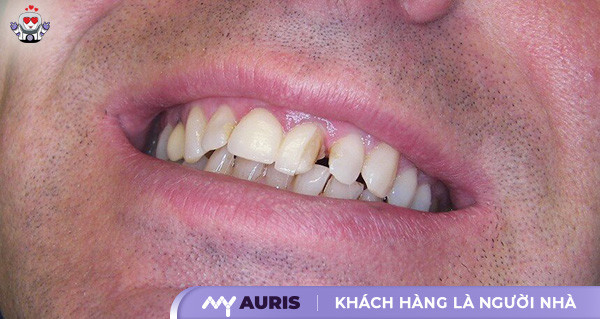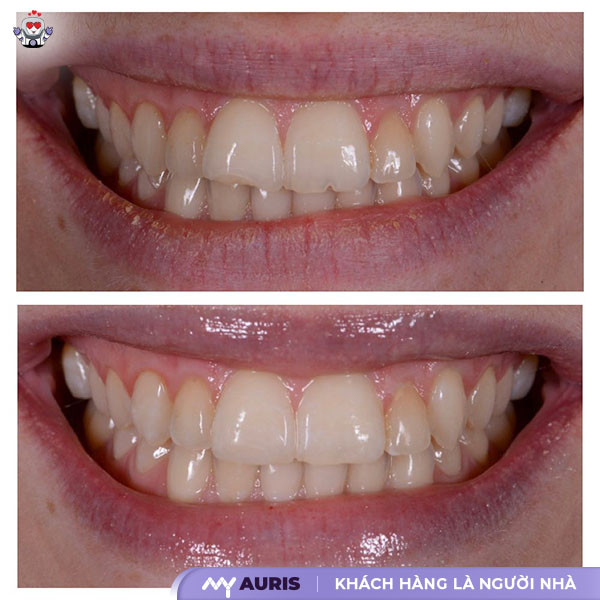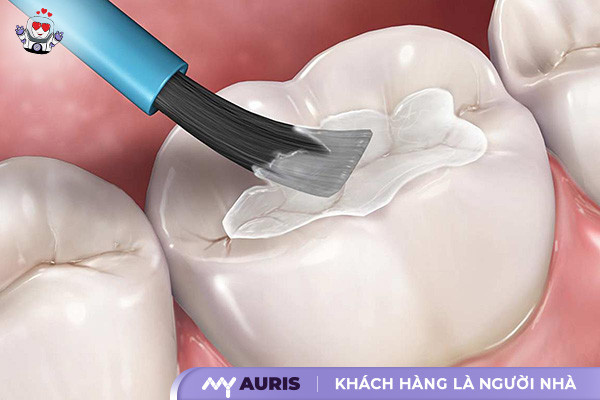Chipped porcelain crowns can be caused by various factors, affecting aesthetics, eating, and oral health. Can chipped porcelain crowns be filled? Let’s explore the effective restoration methods in detail.
Can Chipped Porcelain Crowns Be Filled?
Chipped porcelain crowns are not an uncommon situation and can arise from various causes. Among these, biting into hard objects such as bones, crab shells, pistachio shells, watermelon seeds, or even using teeth to open bottle caps are typical culprits. Such actions can cause tooth pain, leading to cracks or even pulp death, seriously impacting oral health.
Furthermore, the technique used by the dentist and lab technician in creating the porcelain crown plays a crucial role. If there are technical errors during the procedure, the risk of the porcelain crown chipping will be higher. Conversely, when performed correctly, porcelain crowns will be durable and aesthetically pleasing for a long time.
So, can chipped porcelain crowns be filled? The answer is: porcelain crowns cannot be filled like natural teeth. When a porcelain crown is chipped or broken, the most effective solution is to replace it with a new one. In this situation, the dentist will remove the old porcelain crown and replace it with a suitable new porcelain crown.
However, if the chip is small and does not affect aesthetics or chewing function, the dentist may re-contour the chipped area to smooth and polish the surface. This option saves costs while maintaining the aesthetic appearance of the porcelain crown.

What to Do If Your Porcelain Crown Chips?
When experiencing a chipped porcelain crown, many people wonder if it can be filled like a natural tooth. However, this is not feasible because filling materials cannot bond durably with porcelain. In most cases, the dentist will remove the old porcelain crown and replace it with a new one to ensure both function and aesthetics.
However, if the chip is small, causes no pain, and is not deep, the dentist may opt to smooth the chipped area and then polish the porcelain crown’s surface to make it even, without needing a replacement.
As soon as you notice a chipped porcelain crown, you should thoroughly check the area around it to remove any fragments (if present) to avoid swallowing them, which could be dangerous. Afterwards, it is crucial to visit a dental clinic promptly for timely treatment, preventing negative impacts on aesthetics, chewing function, and oral health.
Restoration methods depend on the extent of the porcelain crown chip:
- Re-contouring and polishing the porcelain crown: Suitable for small chips that only affect the outer porcelain layer, causing no sensitivity or discomfort. The dentist will gently re-contour the chipped part and polish the crown’s surface, helping to maintain its beauty and smoothness.
- Replacing with a new porcelain crown: Applied when the porcelain crown has a large chip or fracture, exposing the underlying framework, causing pain or sensitivity. In this case, the old porcelain crown must be completely removed and replaced with a new one to restore chewing function and ensure comprehensive aesthetics.

How Durable Are Fillings for Chipped Porcelain Crowns?
Filling a chipped porcelain crown can be durable. The durability of the filling directly depends on several factors. This is an effective repair solution for small to medium chips. However, it is not a permanent solution like an intact porcelain crown. The average lifespan of a filling on a porcelain crown ranges from 2 to 5 years. This figure can vary significantly.
For an aesthetic and durable filling, all of the following factors need to be optimized:
Extent and location of the porcelain crown chip: This is the most crucial factor. A small chip on the incisal edge of an anterior tooth, where chewing forces are less intense, will be easier to fill and more durable. Conversely, a large fracture on the occlusal surface of a molar will be very difficult to create a stable filling for. The chewing force on molars is very strong. A composite filling, no matter how good, still has limitations in hardness compared to solid porcelain material.
Filling material used for the porcelain crown: The most common material for aesthetic fillings on porcelain crowns is composite. This type of filling material has a color similar to natural teeth and porcelain crowns.
Technique performed by the Dentist: The skill of the dentist performing the porcelain crown filling is a factor that cannot be overlooked. A dentist specializing in prosthetic dentistry will possess sophisticated composite filling techniques to maximize durability.
Patient’s oral hygiene: After the porcelain crown filling procedure is completed, the patient’s home care plays a decisive role in the lifespan of both the porcelain crown and the filling.

Procedure for Filling Chipped Porcelain Crowns
Step 1: Examination, Check-up, and Consultation
The dental professional begins by conducting an overall examination of your oral condition. The dentist will check the status of the natural tooth beneath the porcelain layer. This ensures that there are no underlying issues with the tooth. If the natural tooth is stable, the dentist will provide a prognosis regarding the durability of the filling. You will receive clear consultation on this chipped porcelain crown treatment method, including its advantages and disadvantages.
Step 2: Oral Hygiene and Porcelain Crown Surface Cleaning
The dentist performs a thorough cleaning of the chipped porcelain crown area. All plaque, tartar, and food debris are completely removed. The porcelain surface is isolated from saliva using specialized instruments. A clean and dry surface is a prerequisite for dental adhesive to achieve maximum effectiveness. This step prevents infection and increases the lifespan of the porcelain crown after filling.
Step 3: Surface Treatment of the Chipped Area
This is a crucial technical step. The dentist uses a specialized dental acid (safe for the body) to micro-etch the surface of the chipped area. This process creates microscopic roughness, invisible to the naked eye. Subsequently, a thin layer of porcelain bonding agent is applied. This bonding agent acts as a connector, helping the composite filling material bond securely to the porcelain crown’s structure.
Step 4: Composite Filling Material Application
A dentist specializing in porcelain restorations will select composite filling material that most closely matches the color of your porcelain crown. This requires extensive experience and a keen aesthetic eye to ensure the color, shape, and size of the filling blend seamlessly.
The filling material is applied in thin layers. After each layer, the dentist meticulously sculpts it to recreate the missing tooth structure. The multi-layer composite filling technique gives the filling a translucency and natural light effect similar to natural teeth, achieving superior aesthetics. This material has high biocompatibility with soft tissues and does not cause specific biological reactions.
Step 5: Light Curing to Harden the Material
After the sculpting is complete, the dentist uses a dental device that emits blue light (a light-curing lamp). This light activates the molecules in the filling material, causing them to bond together and harden quickly. This process takes only about 20-40 seconds for each layer of material. The filling will achieve the necessary hardness to withstand basic chewing forces.
Step 6: Bite Adjustment and Polishing
The final step is completion. The dentist will ask you to bite down to check for any high spots or interferences. Any excess contact points will be meticulously adjusted to ensure the most comfortable chewing sensation for you.
Finally, the surface of the filling is polished using specialized instruments. Polishing not only gives the filling a beautiful, natural luster like tooth enamel but also creates a smooth surface, preventing plaque accumulation. At the end of the procedure, you will have a perfect tooth, making it difficult to distinguish where the porcelain crown was repaired.
How Much Does It Cost to Fill a Chipped Porcelain Crown?
Below is a reference price list. Please note, this is the cost per tooth unit and may change after a direct examination by the dentist.
| Service | Extent of Chip | Estimated Cost (VND/tooth) |
| Filling for chipped porcelain crown | Small chip, molar area | 500,000 – 1,000,000 |
| Aesthetic filling for porcelain crown | Medium chip, anterior tooth area | 1,000,000 – 2,500,000 |
| Restoration for large porcelain crown chip | Large, complex chip | Dentist will advise after examination |
| Replacing with a new porcelain crown | Cannot be filled | Quoted according to chosen porcelain crown type |
To get an accurate prognosis and specific treatment costs for your case, you should visit the dental clinic directly. The dentist will examine the cause of the chip, assess its extent, and recommend the most optimal treatment method for you.

My Auris – Where to Get a Chipped Porcelain Crown Filled in HCMC?
Finding a reliable dental clinic among hundreds of options in HCMC is a challenge. A correct decision will help you regain a perfect tooth, ensuring long-lasting chewing function and aesthetics. Conversely, an ill-considered choice could lead to having to redo the entire porcelain crown, incurring significant costs and time. To help you make an accurate decision, My Auris has compiled the most important criteria.
My Auris Dental Clinic is confident in being the address that fully and excellently meets the most stringent criteria for repairing chipped porcelain crowns in HCMC. We build trust from the quality of our treatment and the satisfaction of each patient.
Team of specialized aesthetic restorative dentists: At My Auris, the dentists performing your porcelain crown filling are prosthetic specialists with many years of experience handling complex porcelain restorative cases, from porcelain veneers and crowns to porcelain bridges. Our dentists have a deep understanding of the characteristics of each material, ensuring the selection of the most optimal filling method and material for your tooth condition. Their skillful artistry helps restore the tooth’s shape, size, and color perfectly, returning a flawless tooth to you.
Use of 100% imported high-quality composite materials: My Auris is committed to using only aesthetic composite lines and dental adhesives from leading brands in Germany, the USA, and Japan. These materials have been clinically proven worldwide for their durability, aesthetics, and especially their high biocompatibility. We ensure that the filling will have a natural color, will not discolor over time, and is absolutely safe for your body’s health.
Application of modern technology and equipment: My Auris invests in a system of modern equipment. New-generation light-curing lamps ensure optimal material hardening. Specialized microsurgical instruments allow the dentist to operate with millimeter-level precision. The treatment environment is absolutely sterile according to Ministry of Health standards, completely eliminating the risk of cross-contamination and ensuring patient safety.
Transparent process, reasonable costs: Before treatment, you will receive a direct examination and thorough consultation from the dentist regarding your condition, treatment method, and specific costs. All information is clear, with no hidden fees. My Auris provides a written warranty policy for porcelain crown filling services, giving you peace of mind about the quality and lifespan of your restored porcelain crown.
When a porcelain crown chips, don’t rush to worry. Contact My Auris Dental Clinic immediately to consult with our specialists for the best solution. We will help you restore your intact smile, ensuring your teeth are always strong and perfect.
How to Prevent Chipped Porcelain Crowns: 4 Unmissable Notes
To prevent porcelain crowns from chipping or breaking, you should keep in mind some important points to extend their lifespan and ensure safety during use:
Avoid applying strong forces to porcelain crowns: Porcelain crowns can be damaged if you chew hard foods or bite down on extremely hard items such as bones, seafood shells, or ice cubes. Furthermore, absolutely do not use your teeth to open beer bottles, bottle caps, etc., as this can easily cause cracks, chips, or even complete fractures of the porcelain crown.
Eliminate teeth grinding habits during sleep: The habit of clenching or grinding teeth while sleeping puts significant pressure on porcelain crowns, making them prone to wear and fracture over time. You should use a nightguard or consult a dentist for advice on effective solutions.
Proper care for porcelain crowns: Maintaining good oral hygiene not only protects natural teeth but also porcelain crowns. Brush vertically along the tooth surface, avoiding horizontal brushing to prevent gum recession or cervical wear. Prioritize using a soft-bristled toothbrush to avoid damaging the porcelain crown.
Choose a reputable dental clinic and quality porcelain crowns: To minimize the risk of porcelain crowns chipping or breaking, you should choose a trustworthy dental clinic for crowns and the best quality porcelain crowns within your budget. Investing in initial quality will help ensure the porcelain crowns are durable and safer for long-term use.





